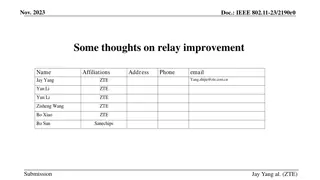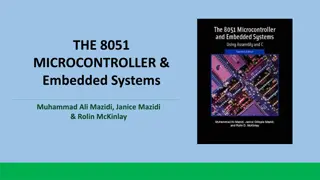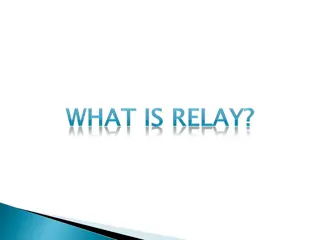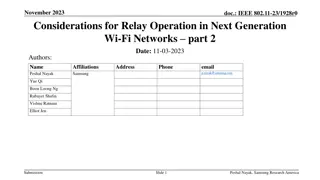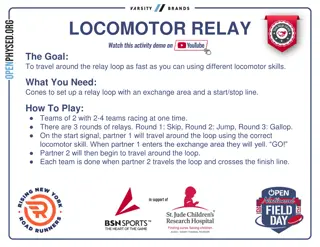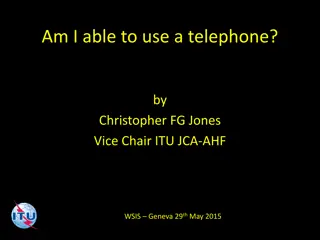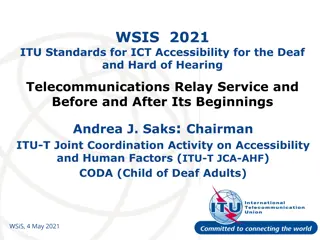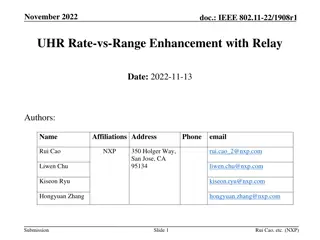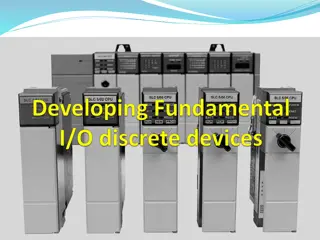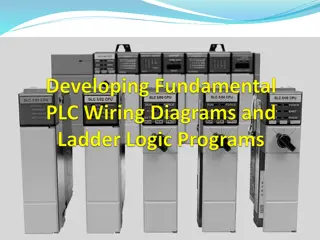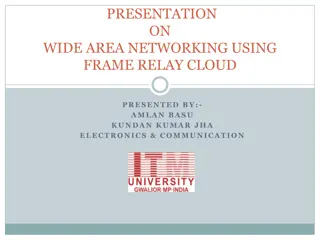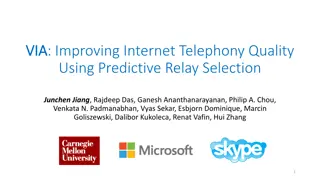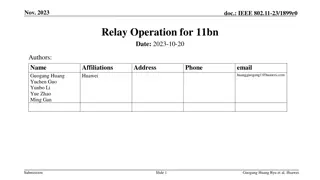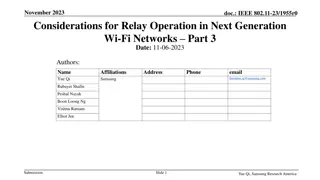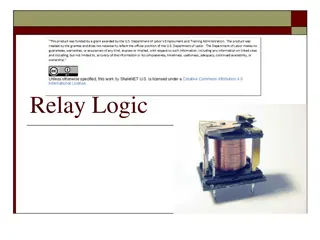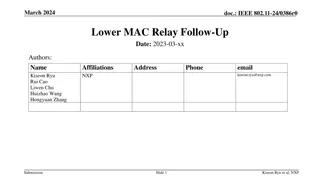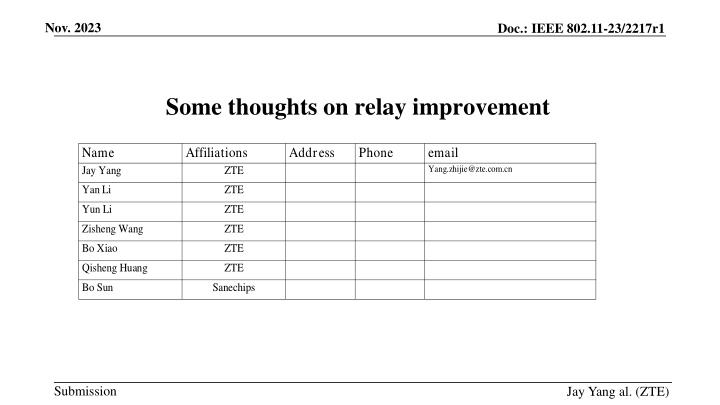
Enhancing IEEE 802.11 Relay Communication: Innovations & Performance Boost
Explore the advancements in relay technology within IEEE 802.11 networks, focusing on ultra-high reliability, throughput improvement, latency reduction, and packet loss mitigation. Delve into network topology variations, relay functions in residential setups, and high-level relay enhancements for enhanced performance and efficiency.
Download Presentation

Please find below an Image/Link to download the presentation.
The content on the website is provided AS IS for your information and personal use only. It may not be sold, licensed, or shared on other websites without obtaining consent from the author. If you encounter any issues during the download, it is possible that the publisher has removed the file from their server.
You are allowed to download the files provided on this website for personal or commercial use, subject to the condition that they are used lawfully. All files are the property of their respective owners.
The content on the website is provided AS IS for your information and personal use only. It may not be sold, licensed, or shared on other websites without obtaining consent from the author.
E N D
Presentation Transcript
Nov. 2023 Doc.: IEEE 802.11-23/2217r1 Some thoughts on relay improvement Name Jay Yang Affiliations Address Phone email Yang.zhijie@zte.com.cn ZTE YanLi ZTE Yun Li ZTE Zisheng Wang ZTE Bo Xiao ZTE Qisheng Huang ZTE Bo Sun Sanechips Submission Jay Yang al. (ZTE)
Nov. 2023 Doc.: IEEE 802.11-23/2217r1 Background UHR PAR illustration Achieve Ultra High reliability, with the improvement on throughput, latency, packet loss,etc. Improve the performance of STA in different range( improve SINR). 11bn SFD(roaming) 11bn defines a mechanism that enables a non-AP MLD to roam from one AP MLD to another AP MLD and the non-AP MLD remains in state 4 (see 11.3) during and after roaming to the other AP MLD Submission Slide 2 Jay Yang, et al. (ZTE)
Nov. 2023 Doc.: IEEE 802.11-23/2217r1 Abstract In this contribution, we will discuss two types of network topology with relay function in residential environment, and analyze the possible UHR feature in relay communication. Submission Slide 3 Jay Yang, et al. (ZTE)
Nov. 2023 Doc.: IEEE 802.11-23/2217r1 Recap-1(easy mesh) In residential environment, S1G-based easy mesh products are widely deployed in many countries. In easy mesh network topology: one MAP Controller can access to WAN MAP Agents(Relay) associates with Controller via wireless /wired backhaul. one or more MAP Agents provide the data relay function(application level relay) for the associated STA. Obviously, all the STAs traffics need to go through MAP controller. Submission Slide 4 Jay Yang, et al. (ZTE)
Nov. 2023 Doc.: IEEE 802.11-23/2217r1 Recap(FTTR) Based on fibre backhaul(BH) connection(Application level wired relay),the MFU provides 2.5Gbps DL and 1Gbps UL throughput for SFUs in each room, and it features low lost, low latency and high reliability. In the near future, the TP on backhaul can up to 10Gbps. About 10 million FTTR products deployed in 2023. The packet lost rate in the BH is about: 10-12 The delay in the BH is about 10us-400us. The fibre is easier to be deployed in/on the wall, which address the pain point of the deployment issue in residential environment. Submission Slide 5 Jay Yang, et al. (ZTE)
Nov. 2023 Doc.: IEEE 802.11-23/2217r1 High level Relay function improvement direction A batch of UHR relay improvement proposal well discussed last year. One of the direction focus on MPDU forwarding to reduce reorder delay(MAC link level relay) 23/1175 UHR relay follow up (Kiseon Ryu) 23/1405 Consideration on UHR Relay Architecture (Kosuke Aio) 24/74 Relay Operation Follow-up(Guogang Huang) Another direction is Joint Transmission to improve the TP significantly - 23/1843 Multi-AP Joint Transmission Simulations with Impairments (Rainer Strobel) -23/243 Joint Transmission for UHR - Additional Results(Ron Porat) -22/1821 System Level Simulation of Co-BF and Joint Tx (Kosuke Aio) (U) (C) (U) (C) IEEE 802.1X IEEE 802.1X Controlled and Uncontrolled Port Filtering (optional) (M) Controlled and Uncontrolled Port Filtering (optional) (M) RX/TX MSDU Rate Limiting RX/TX MSDU Rate Limiting A-MSDU MSDU Flow - Transmitting A-MSDU MSDU Flow - Transmitting MSDU Flow Receiving MSDU Flow Receiving Aggregation (TX) / De-aggregation (RX) Aggregation (TX) / De-aggregation (RX) Replay Detection Per PN (optional) Replay Detection Per PN (optional) PS Defer Queuing1 (AP MLD Only) PS Defer Queuing1 (AP MLD Only) Upper MAC sublayer: tSTA/dSTA only functions Block Ack Buffering and Reordering per SN Block Ack Buffering and Reordering per SN Sequence Number Assignment Sequence Number Assignment MPDU Decryption MPDU Decryption Packet Number Assignment Packet Number Assignment Duplicate Detection per SN Duplicate Detection per SN E2E Block Ack Scoreboarding E2E Block Ack Scoreboarding MPDU Encryption MPDU Encryption Null Null Null Null Relay Block Ack Scoreboarding Relay Block Ack Scoreboarding Null MPDU Header + CRC Creation MPDU Header + CRC Creation MPDU Header + CRC Creation Address 1 address filtering Address 1 address filtering Address 1 address filtering lower MAC sublayer: Relay functions MPDU Header + CRC Validation MPDU Header + CRC Validation MPDU Header + CRC Validation A-MPDU Aggregation A-MPDU Aggregation A-MPDU Aggregation A-MPDU De-aggregation A-MPDU De-aggregation A-MPDU De-aggregation (PHY SAP) (PHY SAP) (PHY SAP) PHY of tSTA PHY of dSTA PHY of rSTA dSTA tSTA rSTA Submission Slide 6 Jay Yang, et al. (ZTE)
Nov. 2023 Doc.: IEEE 802.11-23/2217r1 Motivation Obviously, Easy mesh, FTTR and other Relay product have the similar framework, in which all Clients traffic need to go through the root AP/MFU. Therefore, we would like to see a centralized UHR High MAC located at root AP/MFU to manage all UHR clients traffic in the new relay function. Also we would like to see how the following features work in the D-AP MLD framework link level relay function(from Root AP to Relay) Seamless roaming(between Relay to Root AP, or between Relays) Joint Transmission(Specially in FTTR or other cable BH product) Submission Slide 7 Jay Yang, et al. (ZTE)
Nov. 2023 Doc.: IEEE 802.11-23/2217r1 D-AP MLD framework for link level relay function Root AP: Has additional UHR common MAC function, constructs MPDUs Relay: Has additional UHR Low MAC and PHY function, forwards MPDUs between UHR Client and Root AP without encryption/decryption. Note: To compatible with pre-UHR Client, Relay also has pre-UHR full MAC function. Client: may require to decode new MPDU format or UHR signaling. Submission Slide 8 Jay Yang, et al. (ZTE)
Nov. 2023 Doc.: IEEE 802.11-23/2217r1 D-AP MLD framework for seamless roaming Root AP: Before rooming, Root AP transmits the constructed DL MPDUs via Relay1. After rooming, Root AP transmits the DL MPDUs via Relay2, and buffer the undelivered MPDUs. And thus it can achieve 0 packet lost during roaming procedure. Relay: (If assume Relay also can buffer MPDUs)drop the undelivered MPDUs directly if STA roams to another Relay. Client: Client control the whole roaming procedure. Submission Slide 9 Jay Yang, et al. (ZTE)
Nov. 2023 Doc.: IEEE 802.11-23/2217r1 D-AP MLD framework for Joint Transmission Root AP: Transmit the same or different MPDUs via BH. Relays: Jointly transmit the received MPDUs to the Client at the same time. Client: receive the same or different MPDUs from two Relays, and decode the received MPDUs together. Case 1-same MPDUs Case 2-Different MPDUs Submission Slide 10 Jay Yang, et al. (ZTE)
Nov. 2023 Doc.: IEEE 802.11-23/2217r1 The challenge and possible solution for JT The mainly challenge in JT Joint TX requires tight time/frequency synchronization between multiple APs. Possible solution for time synchronization in FTTR product SFUs always synchronization with MFU in PON system PON clock can provide 10-11 granularity reference: ITU-T G.987.2), PON system also support IEEE 1588 for time synchronization. It s naturally each AP synchronize its WIFI clock synchronized from its PON(e.g. synchronize period: 125us) system, and the time synchronization requirement can be met. Submission Slide 11 Jay Yang, et al. (ZTE)
Nov. 2023 Doc.: IEEE 802.11-23/2217r1 Summary Recap some residential network topology (Easy Mesh and FTTR). Analyze a high level D-AP MLD framework in residential environment. Analyze the link level relay, seamless roaming and JT in D-AP MLD framework Submission Slide 12 Jay Yang, et al. (ZTE)
Nov. 2023 Doc.: IEEE 802.11-23/2217r1 Reference [1]802.11bn PAR [2] ETSI GR RIS 006 V0.0.2 [3] ITU-T G.9940(G.fin-SA) High speed fibre-based in-premises transceivers system architecture [4]23-1138-Features to consider for efficient Relay operation [5]23-1146-Relaying for Low Latency Traffic in UHR [6]23-1175-UHR relay follow up Submission Slide 13 Jay Yang, et al. (ZTE)
Nov. 2023 Doc.: IEEE 802.11-23/2217r1 SP1 Do you agree to define D-AP MLD framework in relay communication, in which root AP has the additional UHR high MAC function, and relay has the additional UHR low MAC function? Note: the backhaul connection between root AP and relay may be wireless or wired. And the D-AP MLD framework refers to figure in slide 8. Submission Slide 14 Jay Yang, et al. (ZTE)
Nov. 2023 Doc.: IEEE 802.11-23/2217r1 SP2 Do you agree to optionally support Joint Transmission in D-AP MLD framework? Submission Slide 15 Jay Yang, et al. (ZTE)

